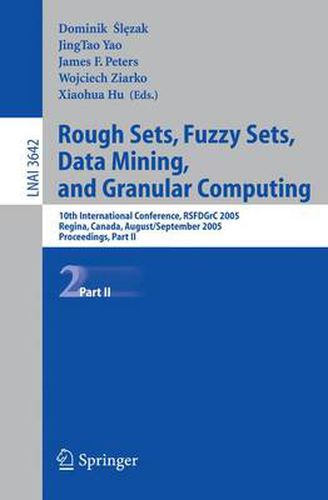Readings Newsletter
Become a Readings Member to make your shopping experience even easier.
Sign in or sign up for free!
You’re not far away from qualifying for FREE standard shipping within Australia
You’ve qualified for FREE standard shipping within Australia
The cart is loading…






This title is printed to order. This book may have been self-published. If so, we cannot guarantee the quality of the content. In the main most books will have gone through the editing process however some may not. We therefore suggest that you be aware of this before ordering this book. If in doubt check either the author or publisher’s details as we are unable to accept any returns unless they are faulty. Please contact us if you have any questions.
This volume contains the papers selected for presentation at the 10th Int- national Conference on Rough Sets, Fuzzy Sets, Data Mining, and Granular Computing, RSFDGrC 2005, organized at the University of Regina, August 31st-September 3rd, 2005. This conference followed in the footsteps of inter- tional events devoted to the subject of rough sets, held so far in Canada, China, Japan,Poland,Sweden, and the USA. RSFDGrC achievedthe status of biennial international conference, starting from 2003 in Chongqing, China. The theory of rough sets, proposed by Zdzis law Pawlak in 1982, is a model of approximate reasoning. The main idea is based on indiscernibility relations that describe indistinguishability of objects. Concepts are represented by - proximations. In applications, rough set methodology focuses on approximate representation of knowledge derivable from data. It leads to signi?cant results in many areas such as ?nance, industry, multimedia, and medicine. The RSFDGrC conferences put an emphasis on connections between rough sets and fuzzy sets, granularcomputing, and knowledge discoveryand data m- ing, both at the level of theoretical foundations and real-life applications. In the case of this event, additional e?ort was made to establish a linkage towards a broader range of applications. We achieved it by including in the conference program the workshops on bioinformatics, security engineering, and embedded systems, as well as tutorials and sessions related to other application areas.
$9.00 standard shipping within Australia
FREE standard shipping within Australia for orders over $100.00
Express & International shipping calculated at checkout
This title is printed to order. This book may have been self-published. If so, we cannot guarantee the quality of the content. In the main most books will have gone through the editing process however some may not. We therefore suggest that you be aware of this before ordering this book. If in doubt check either the author or publisher’s details as we are unable to accept any returns unless they are faulty. Please contact us if you have any questions.
This volume contains the papers selected for presentation at the 10th Int- national Conference on Rough Sets, Fuzzy Sets, Data Mining, and Granular Computing, RSFDGrC 2005, organized at the University of Regina, August 31st-September 3rd, 2005. This conference followed in the footsteps of inter- tional events devoted to the subject of rough sets, held so far in Canada, China, Japan,Poland,Sweden, and the USA. RSFDGrC achievedthe status of biennial international conference, starting from 2003 in Chongqing, China. The theory of rough sets, proposed by Zdzis law Pawlak in 1982, is a model of approximate reasoning. The main idea is based on indiscernibility relations that describe indistinguishability of objects. Concepts are represented by - proximations. In applications, rough set methodology focuses on approximate representation of knowledge derivable from data. It leads to signi?cant results in many areas such as ?nance, industry, multimedia, and medicine. The RSFDGrC conferences put an emphasis on connections between rough sets and fuzzy sets, granularcomputing, and knowledge discoveryand data m- ing, both at the level of theoretical foundations and real-life applications. In the case of this event, additional e?ort was made to establish a linkage towards a broader range of applications. We achieved it by including in the conference program the workshops on bioinformatics, security engineering, and embedded systems, as well as tutorials and sessions related to other application areas.